Putting Ourselves on the Map
vol.3
Let's Go on an Anime Pilgrimage (Extra edition)
Nose Watari, Fukuoka prefecture Onoguchi Taichi, Fukuoka prefecture
2016.07.07
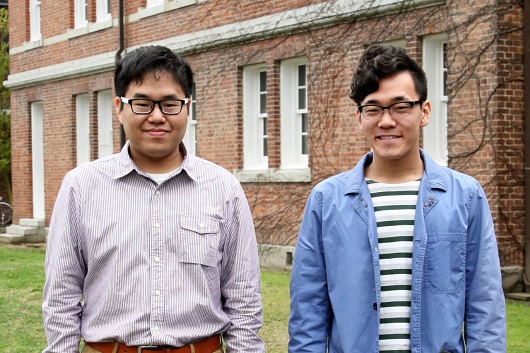
©Nakasai Chiya
Nose Watari (right) with Onoguchi Taichi
After starting university in 2014, Nose created an anime study group. Onoguchi joined soon after entering the university in 2015. They talk about the attraction of anime and their fascination with making pilgrimages to the "sacred sites" (seichi) that are the original settings for anime stories.
The Attraction of Anime Pilgrimage
Q: We hear that you made a presentation on anime pilgrimages at your school festival last year. What site did you talk about? Had you visited various anime sites before that?
Nose: Last year the nine members of the Anime Study Group went to Uji, Kyoto, the setting for TV anime program Hibike! Yūfoniamu (Sound! Euphonium). That was my first pilgrimage.
Onoguchi: The first time was in high school when I went to the site of Tamayura (directed by Satō Jun'ichi) in Takehara, Hiroshima prefecture with two of my friends. It was easy to get to by catching the first train of the morning in Fukuoka; we got to Takehara by noon. Later, as a trip to celebrate our high school graduation, six friends and I went to Tokyo and Saitama prefecture using the Japan Railways "Seishun 18 Kippu" tickets.* Our destinations were Akihabara, which is the site of all sorts of anime, and the area of the Chichibu mountain region that was the setting for the much-talked-about Ano hi mita hana no namae o bokutachi wa mada shiranai (We Still Don't Know the Name of the Flower We Saw That Day).
Actually, my friends and I were railroad buffs, so our primary purpose was riding the rails, but we decided if we were going somewhere we'd make it an anime pilgrimage trip.
* "Seishun 18 Kippu" tickets allow all-you-can-ride on JR trains for one day except for Shinkansen, special express, and express trains.
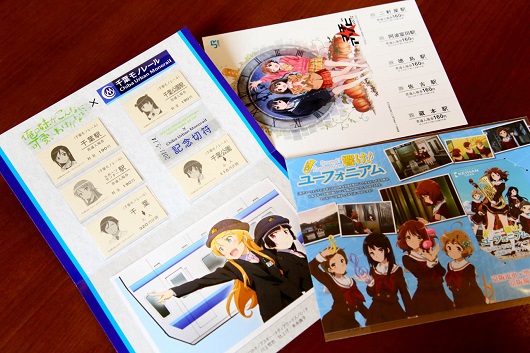
©Nakasai Chiya
Q: Please tell us about the attraction of visiting anime pilgrimage sites.
Nose: When you go to a place and take photos of the same scenery that appears in an anime, you can savor the feeling of being part of the work and closer to the atmosphere it portrays. Another attraction is the chance to go to a place you normally wouldn't go to. For example, you might go to the central parts of Kyoto, but you might not go to a suburb of Kyoto like Uji. When we went to the actual place, we realized what a cool place it was.
Anime Pilgrimages Benefit Local Economies
Q: How do you find out where the original settings of the anime are? Do you figure that out yourselves?
Nose: Usually you can find information online made available by people who have already been there. Some local governments are also providing this kind of information as a part of their local tourism campaigns.
Onoguchi: It is actually fun to go in search of these settings ourselves, but often they are places that only local people know. It's hard to know how much you can figure out and how much you need to rely on information provided by others. Anime pilgrimage sites that have the backing of local governments are easy to find, but there are pros and cons to that. Some places have become successful tourist spots, like Ōarai in Ibaraki prefecture, site of the Girls and Panzer, and the Tamayura site in Takehara, but we've heard of some that are big failures.
Nose: I'm all in favor of local governments linking up with anime pilgrimages. The information and signage they provide is a big help to people who are just getting started, making it a lot easier. And I think that the economic stimulus to a locale brought by anime fans could be significant. There are quite a few places in the Kansai and Kanto areas where this is happening, but not so much in our region of Kyushu. We'd really like to get an anime work that's set in the Kyushu area.
Onoguchi: It's really cool when a locale that you know becomes the setting of an anime. There's a place near where I live, in fact, that appears in Sketch Book Full Colors; I even visited there today, too. But the condition for anime pilgrimage to really be exciting is that the anime itself generates plenty of buzz.
Learning from Different Perspectives
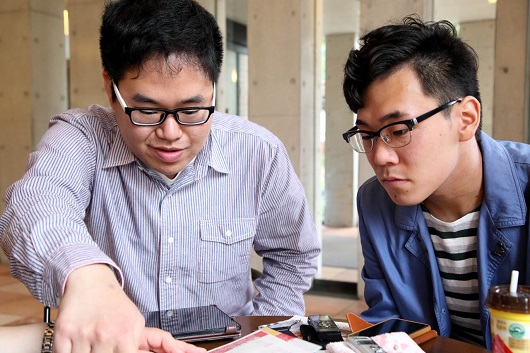
©Nakasai Chiya
Q: So what was it that made you decide to start up an anime study group?
Nose: Well, mainly because my university didn't have anything like it already. High school wasn't a place where you could really talk about anime much, so in university, I really wanted a place where I could watch anime and talk about them with other people. It was around July of my first year that a friend of mine and I started up the study group. When in our second year, we had seven more members, our activities really got off the ground.
Q: So what kind of activities do you have?
Nose: Our weekly activities consist of watching anime films and sharing comments on them. We each bring a PC to watch the anime of our own choice. We also sometimes all watch the same anime, projecting it on a screen in a classroom. Once a month, we have presentations by members who talk about a work they want to introduce to the others. These presentations are great opportunities to see all sorts of anime, sometimes getting us interested in a genre we hadn't known much about before. That was how I learned about robot anime. When you're just watching anime you like all the time, you get stuck in a rut. The study group is a great place to learn about all sorts of anime.
Onoguchi: When we all watch the same anime and then compare why we like or don't like it, we get fresh perspective on the work.
I often check the Web for sites that study and think about the meaning and intent of the scenes and characters in particular anime works. Sometimes there are various deep meanings invested in scenes that might appear just momentarily, and that is part of the fascination of anime. It's possible because, unlike live filming, everything in anime is made up.
Nose: You can feel that in the music that is used as well. For example, in the scenes where the main character in Evangelion is fighting, you'll hear golden oldies like "Kyō no hi wa sayonara" (Goodbye for Today), "365-ho no māchi" (The 365-Step March), and "Tsubasa o kudasai" (Give Me Wings). Those are not at all songs that glorify fighting but actually project the opposite image, so you start to wonder what the underlying motive is for using them as accompaniment.
The Enjoyment of Anime Isn't Just for Children
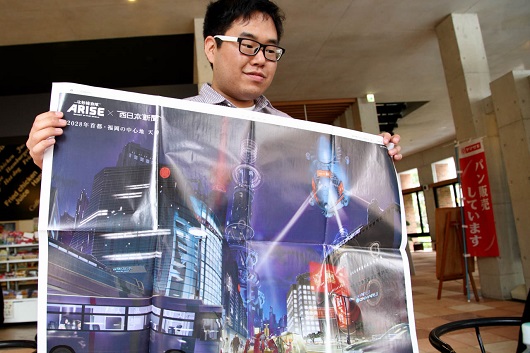
©Nakasai Chiya
Q: When and what kind of anime got you so interested in them?
Nose: For me it was in junior high school, when I saw Evangelion. I really identified with the protagonist, because I was just about his age and struggling with the same sorts of adolescent conflicts and anxieties. And until then, I had only known the anime for kids like Doraemon and Pokemon, and was surprised to discover anime that wasn't just entertainment but made you think.
Onoguchi: I, too, got hooked on anime with Evangelion while in junior high school. After that what I really remember was Higashi no Eden (East of Eden). It was one of the social-issue anime, which dealt with medical care, elder care, and other problems in Japanese society, and portrays the kind of chronic anxiety that pervades society. The story has depth and makes you think. There's no happy ending.
Nose: I, too, basically tended to like the anime that treated more serious topics, but after watching a variety of them, I gravitated toward the more entertaining ones--especially the bukatsu ones that portray characters in secondary school after-school clubs like K-On! (K-On Light Music Club) and Hibike! Yūfoniamu (Sound! Euphonium).
K-On!
http://www.tbs.co.jp/anime/k-on/
Hibike! Yūfoniamu
http://anime-eupho.com/
Q: Why was it that you like the school club anime? Did they reflect what you yourself were experiencing?
Nose: Actually, I myself hadn't joined any school club, so reading the anime made for a kind of vicarious experience, and then I would try doing some of the things depicted in the anime. Like after reading K-On, I tried playing the guitar a bit . . .
The fact that I created the anime club in university came out of my desire to experience a school club for myself--doing something I liked together with my buddies. Then, too, you know, people see anime in different ways, so I thought if we got different kinds of people together we could expand the way we were seeing the anime.
Onoguchi: In junior high and senior high school, I did have the chance to talk about anime with my friends, but that was why I wanted to do it as part of a club in university.
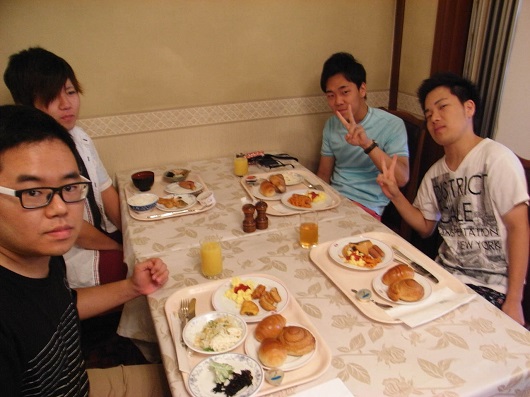
Photography courtesy of Nose Watari
Anime Is a Means of Communication
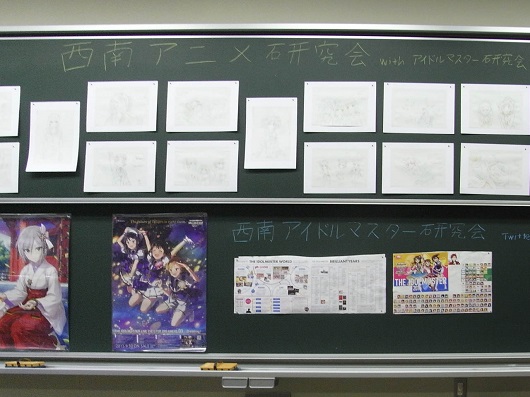
Photography courtesy of Nose Watari
How did the people around you respond to your founding of the Anime Study Group and your love of anime?
Nose: I actually worried a bit about what people would say. But when I did found the club, their attention was rather drawn to the fact that I had founded a club. I got some admiring comments and that made me pretty happy.
Society in general, however, doesn't have a very positive image of people interested in anime. In news reporting, for example, if somebody who committed a crime was interested in sports, they don't even mention it, but if that person liked anime, they would give it a lot of attention.
Onoguchi: That's really true. The criticism goes in strange directions.
Anime pilgrimages are recently getting a fair amount of attention, but when you think about it, it's not really that new. You'll recall the days when huge numbers of Japanese fans of the 2002 Korean drama Fuyu no Sonata (Winter Sonata) visited Korea--that was the same sort of "pilgrimage." Going back even further, there was Roman Holiday with Audrey Hepburn, which made the settings that appeared in the film into tourist attractions. What's different about anime pilgrimages is mainly that the settings and the story are fiction, so it is probably because of a gap between pilgrimage sites and actual places, the media often covers anime pilgrimages.
Nose: The whole thing still tends to be tainted by the negative image carried by "otaku" culture. But the number of people who love anime is surprisingly large. Like the guy I work with on my part-time job has an anime song as the ring melody on his cell phone. When I heard that, we got to talking, and we became friends. So in that way, anime can be a means of communication. Anyway, I hope people won't hold misplaced biases against anime.
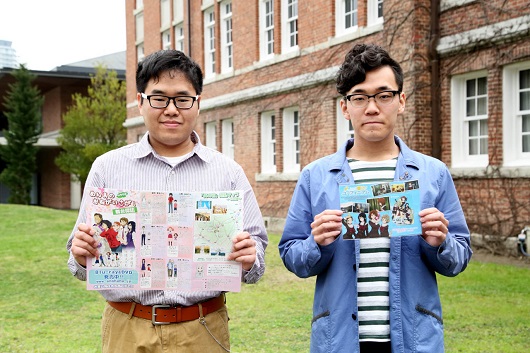
©Nakasai Chiya



